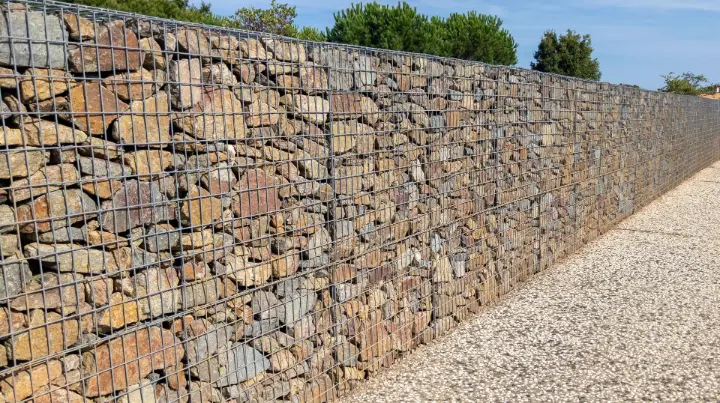The massive development of the infrastructure in Saudi Arabia is associated with complicated engineering issues. Roads that pass through mountainous terrain, valleys and desert slopes are prone to erosion of soils, soil movements and water drainages. Customary wall retaining mechanisms, e.g. reinforced concrete walls, are dependable yet costly, stiff, and tedious to set up.
Here stone cage retaining walls, also called gabion walls, are demonstrating their worth. They provide their customers with a combination of engineering accuracy and the strength of natural stones to offer durability, flexibility and environmental benefits.
Recently Hitech Gabion finished a significant retaining wall project on a Saudi highway illustrating how the modern technology of gabion can be superior to the traditional practices.

The Project Background
There was a major Saudi highway stretch that had been experiencing:
- Frequent passages of the slope soils during the seasonal rainfalls.
- Soil erosion into the road led to traffic disruption.
- Costs of high maintenance as a result of temporary repairs using concrete patching.
The Ministry of Transport needed a long-term, low maintenance and environmentally friendly solution. Following the analysis of alternatives, the Hitech Gabion was selected because it has expertise in the large scale of the gabion baskets.
The reason to use a Stone Cage Retaining Wall?
Several practical advantages affecting the choice of the retaining wall to be used were:
Flexibility Under Pressure
Gabions are also self-adjusting to the soil movement creating less danger of cracks or unexpected wall collapses.
Built-in Drainage
The stone fill permits rainwater to flow through it eliminating hydrostatic pressure, one of the usual causes of concrete wall collapse.
Cost Efficiency
Gabion systems are cheaper in the initial installation and in the maintenance.
Durability in Harsh Climate
The wall will be built using the PVC-coated galvanized wire and hard local stones such as basalt and granite to carry a lifespan of 50+ years.
Environmental Fit
The utilisation of locally sourced stone reduced costs in transportation and carbon footprint, which conformed to green building projects in Saudi Arabia.
Engineering Approach at Hitech Gabion.
Rather than just providing baskets, Hitech Gabion provided a turnkey engineering solution. The process included:
- Detailed Site Survey: Slope angles and soil analysis were carried out to come up with a perfect wall structure.
- Custom Basket Design: Gabion baskets were made large with highway grade stability.
- Stone Choice: Basalt and granite were chosen as they are strong and hard to remain in the weather.
- Layered Installation: Baskets, interlocked with each other were used to create a stepped retaining wall.
- Integration of Drainage: Stones had natural gaps that would permit water flow, thus minimizing erosion.
This methodological solution guaranteed that the wall was not only powerful but also long term sustainable.
Gabion vs Concrete Walls
To help decision-makers choose the ideal retaining wall solution, the following comparison highlights key differences between concrete and stone cage (gabion) retaining walls.
| Feature | Concrete Retaining Wall | Stone Cage Retaining Wall (Gabion) |
|---|---|---|
| Cost | High upfront + maintenance | Lower upfront + minimal maintenance |
| Durability | Prone to cracks & repairs | Flexible, lasts 50+ years |
| Drainage | Needs extra systems | Built-in natural drainage |
| Construction Speed | Months | Weeks |
| Environmental Value | High carbon footprint | Uses local/recycled stone |
| Design Flexibility | Limited | Can be curved, stepped, or tiered |
Results of the Project
The finished gabion wall produced results that were not to be expected:
- Improved Road Safety: The slope failures did not continue to occur after installation.
- Reduced Cost: Project costs were 25-30 percent less than what would otherwise have been costs had reinforced concrete been used.
- Accelerated Timeline: The wall was installed in weeks, as opposed to months needed to install concrete.
- Durability: When it has the right mesh and the right stone the wall is projected to take over 50 years with minimal maintenance.
- Eco-Friendly Result: Local stones and recycled aggregates decreased the amount of carbon footprint of the project.
The importance of this case to Saudi Projects.
The growth of infrastructure in Saudi Arabia is going to go on and Vision 2030 initiatives will require sustainable and affordable solutions. Stone cage retaining walls are also gaining momentum as a more intelligent substitute to hard concrete, in particular highways, railways, flood control, and landscaping of villas.
- To decision-makers, the case study gives evidence that:
- Gabions lower the initial and maintenance expenses.
- They provide a time saving installation that puts the project on schedule.
- They are in line with architectural and environmental aesthetics.
Final Thoughts
The case study about the Saudi highway proves that stone cage retaining walls are not merely a decoration option but a design solution to a problem that requires engineering. Through cost savings, durability and sustainability, Hitech Gabion demonstrated that the gabions are capable of meeting the most demanding infrastructure needs.
In future projects in Saudi Arabia, be it highway, urban, or villa estate, the aspect of debating whether to apply the gabion technology can offer sustainable output that balances functionality, aesthetics and accountability.